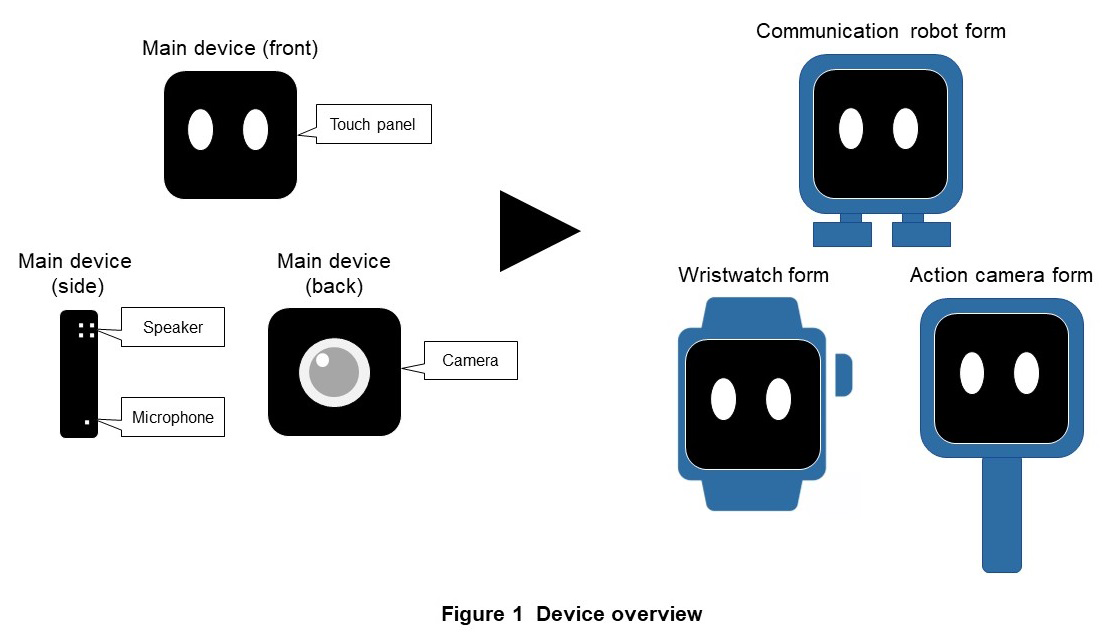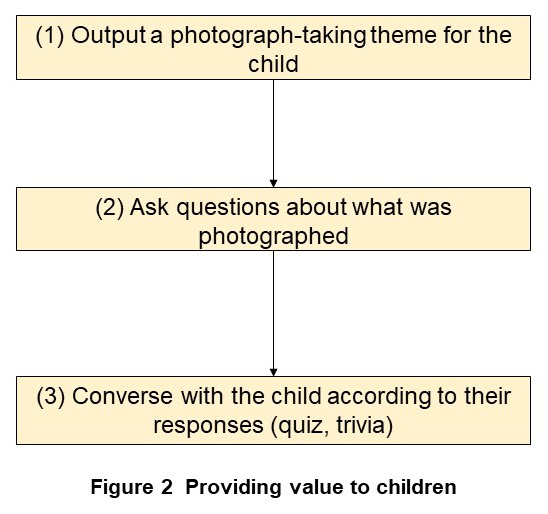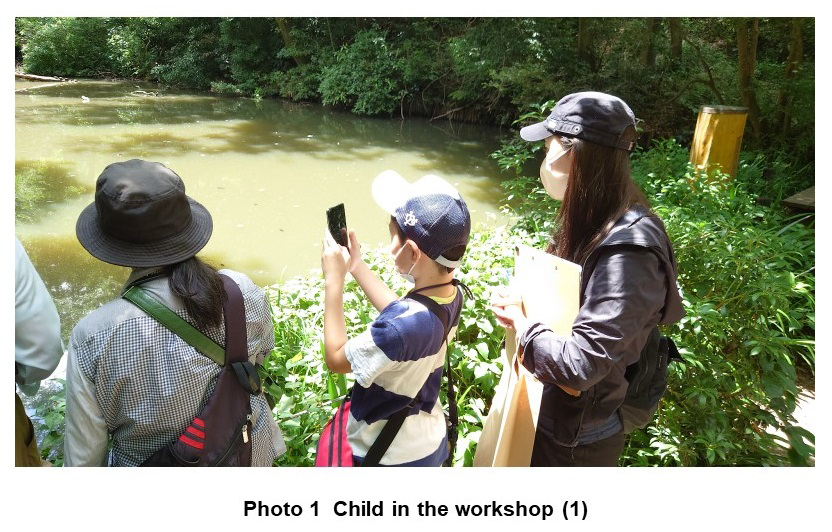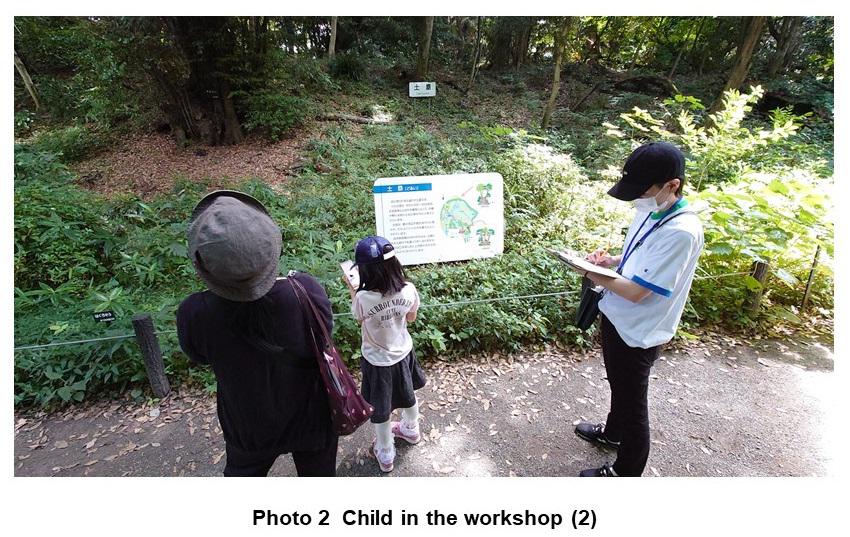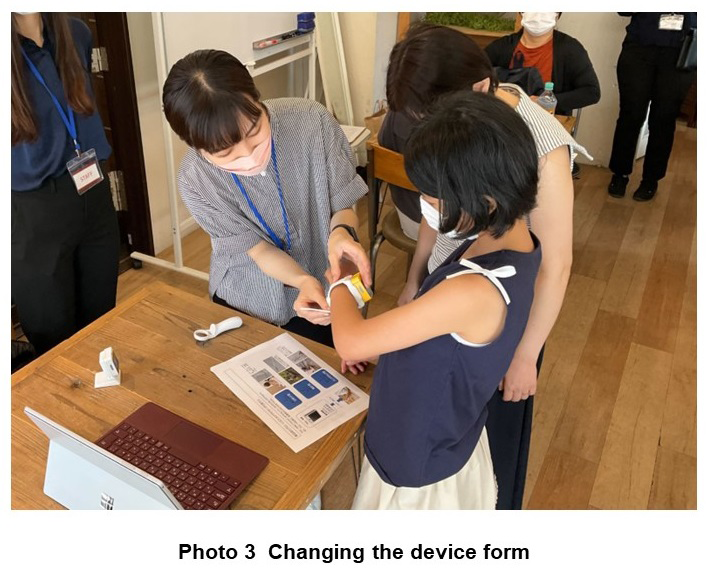New Prototype Device Supporting Children’s Inquiry-based Learning
Compact Device Inquiry-based Learning Emotion Inference
Naoya Yokono†, Hiroki Kameyama, Risa Yamaguchi and Kohei Ozawa
Product Department
† Currently, Service Innovation Department
Abstract
As we approach Society 5.0, a future that our children will inherit, we need to nurture in them an ability to learn subjectively and an ability to find questions and investigate them on their own (inquiry-based learning ability). Considering this need, we have designed and developed a new device able to nurture this inquiry-based learning ability through conversation and a photo-taking experience, and conducted a trial with elementary school students. We have also studied additional functionality to develop in the future, based on the results.
This article describes the issues we focused on, the concept and features of our device and the trial we conducted, and gives an overview of a feature that will infer children’s interests based on conversation between the device and the child.
01. Introduction
-
In Society 5.0*1 [1], advanced technologies such as Artificial Intelligence ...
Open

In Society 5.0*1 [1], advanced technologies such as Artificial Intelligence (AI), big data, the Internet of Things (IoT), and robotics will be implemented in society and the structure of industry, including employment, is expected to change greatly. In such a society, routine work will be replaced by AI, and work is expected to involve mainly people acting on information collected by AI. To prepare for the arrival of Society 5.0, research and development capabilities in fields such as AI and the underlying fields of mathematics and information science are the very important for a country. Unfortunately, Japan lags behind in these fields compared to some other countries. Therefore, it is an urgent issue to develop human resources with advanced knowledge in these fields [2].
To this end, the Ministry of Education, Culture, Sports, Science and Technology (MEXT) has revised educational guidelines for elementary and secondary schools, focusing on learning that is deeply subjective and interactive (active learning) and setting out education policies that emphasize cultivation of children’s inquiry-based learning ability, so that they can find questions and investigate them on their own. Initiatives related to inquiry-based learning go beyond those of MEXT. The Ministry of Economy, Trade and Industry’s vision for a “Mirai-no-Kyousitsu,” also touches on this idea, and there are trial projects being conducted between educational institutions and private enterprises [3]. However, initiatives in the area of devices to stimulate a spirit of inquiry in children and to support the discovery and exploration of new interests are just starting to develop.
NTT DOCOMO has developed a compact device that provides a conversational and photo-taking experience with hints to promote learning, stimulates children’s spirit of inquiry and supports discovery and exploration of new interests. We have also conducted a trial of the device with elementary school students and have proposed features for future development based on results of this trial.
This article describes issues we focused on related to inquiry-based learning, the concept and features of the device we developed and the trial conducted using the device. We also give an overview of a feature we will develop in the future, which infers a child’s interests from conversation between the device and the child.
- Society 5.0: A new economy and society being advocated by the government, maximizing utilization of ICT and enhancing life for everyone, as a successor to hunter-gatherer society, agricultural society, industrial society, and information society.
-
An overview of the device NTT DOCOMO developed to nurture children’s inquiry-based ...
Open

An overview of the device NTT DOCOMO developed to nurture children’s inquiry-based learning ability is shown in Figure 1. It is equipped with a touch panel, speaker, microphone, and camera, and it supports wireless LAN communications. It also has a compact design that children will love and want to take with them. By attaching accessories to the main device, it can also be used in three different forms: as a communication robot that can be placed on a table, as a wristwatch that can be taken outside easily, or as an action camera specialized for taking pictures. This enables the device to be used for learning in all kinds of scenarios: inside, outside, or carried around.
The device is equipped with a photo-taking function and a scenario-based conversation function to nurture children’s inquiry-based learning ability. Use of these functions provides value to the children through the sequence shown in Figure 2.
- Photo-taking themes are pre-set in the device and presented to the child to encourage them to take photos. For example, a theme could be suggested by saying “Find something red and take a picture of it.” These themes, such as “something red,” or “something round,” were selected to be easy to find in everyday life so that children will not be discouraged from taking photos.
- When the child takes a photo according to the theme, the device asks the child questions about what they photographed. For example, it could ask what it is, or why the child photographed it, to encourage children to organize their knowledge or express their own thoughts. It could also say something to praise the child for taking the photo and acknowledge the child’s thoughts. This encourages the child’s self affirmation and motivates them to take the next picture.
- Converse with the child according to their responses. This conversation is designed to be scenario-based, so responses from the device will differ depending to the child’s responses. In the conversation, the device can also provide deeper knowledge through quizzes or trivia. The conversation can also include genres beyond the subject of the photograph, exploring new interests for the child.
These functions were designed based on two assumptions: that “children inquire into a question from knowledge they have gained through experience,” and that “inquiry is deepened by providing information related to one’s own actions.”
The configuration of a system implementing these functions is shown in Figure 3. The device acquires information on the photograph taken and what the child says, and sends it to the server through wireless LAN. The server computes an appropriate response from the information sent by the device and utterance scenarios stored in the server, and then sends instructions to the device.
The device was developed through collaboration with a partner enterprise in the toy industry and the scenarios were developed with a partner enterprise in the education industry.
-
We conducted a trial using the device described above. The objective of the trial was ...
Open

We conducted a trial using the device described above. The objective of the trial was to verify whether the device function could incite interest, expression, and a spirit of inquiry in children.
We conducted workshop and interviews with 32 pairs of elementary school children in grades 1 to 6 and their guardians. Guardians highly interested in children’s education and their children were selected as participants. The workshop was held in a natural green space inhabited by many plants, insects, and birds. In the workshop, each child was accompanied by their guardian and an observer, who made careful observations while the child moved through the natural space while using the device.
The workshop involved taking photos and having scenario-based conversation with the device. For this trial, we had the children take photographs and engage in scenario-based conversation on two themes from among multiple scenarios in the device: “things that are interesting,” and “things that are round.” This was done to provide a broad range that the elementary school students could understand easily, and to make it easy to find things to photograph in the natural environment. In taking photos, the children actively and freely photographed what attracted their own interest, and many could be seen enjoying and learning about plants, insects and birds in the green space. Photos 1 and 2 show images from the workshop. Only a limited number of prototype devices were developed, so we also developed a smartphone application with the same functions to enable more children to have this experience. The children in the photos are using a smartphone with this application installed.
In the workshop, the children were also very interested in changing between the three forms of the device, and seemed to enjoy changing the accessories. This confirmed the need for and receptivity toward having such accessories. Photo 3 shows a child changing the form of the device.
After the workshop, we conducted surveys and interviews to hear how the trial contributed to children discovering new interests, expressing themselves, and stimulating their spirit of inquiry. In results from the survey and interviews, 87% of guardians responded that the device was effective in promoting inquiry-based learning, confirming that it has a certain effect on such learning. 48% of children also responded that they found new interests, indicating that the device contributed to helping them discover new interests. We also discovered that there is demand for a function to help guardians understand their children’s interests through the use of the device.
-
Based on results of the trial, we plan to develop a function that will infer ...
Open

Based on results of the trial, we plan to develop a function that will infer a child’s interest from conversation between the child and the device.
In the past, several technologies that infer a person’s interests through conversation have been proposed, but the use cases have been limited to those in which the content of statements by the party are clear, and cases when statements were ambiguous have not been considered. In observing the trial described above, often the responses given to the device by the children were ambiguous, so we expect it would be difficult to infer the child’s interest from their conversation with the device using the earlier methods.
As such, NTT DOCOMO is studying a technology that will make an inference of interests based on three indices. In addition to the content of utterances by the user, it also considers questions to the user by the device, and the emotion reflected in utterances by the user. Here, for the content of questions asked to the user by the device, questions that are more specific to the subject are designed to receive a higher score, and when assessing emotion in responses, positive emotions such as delight and enjoyment receive a higher score. Each of the derived indices will be given a weighting, and finally used to infer the user’s interests.
-
This article has given an overview of a device designed to nurture children’s ...
Open

This article has given an overview of a device designed to nurture children’s inquiry-based learning ability to find and investigate questions on their own. It also described a trial conducted using prototype devices and functions being studied for future development, based on the results of the trial. NTT DOCOMO will continue to develop devices and functionality designed to nurture children, who will inherit Society 5.0 in the future.
-
REFERENCES
Open

- [1] Japan Cabinet Office: “Science and Technology Policy - Society 5.0,” Accessed Dec. 2022.
 https://www8.cao.go.jp/cstp/english/society5_0/
https://www8.cao.go.jp/cstp/english/society5_0/ - [2] Ministry of Education, Culture, Sports, Science and Technology: “Chapter 3 Strengthening Basic Research Capacity as Foundation of Society 5.0,” 2021 White Paper on Science, Technology and Innovation.
 https://www.mext.go.jp/en/content/20220209-mxt_kouhou02-000020518_9.pdf
https://www.mext.go.jp/en/content/20220209-mxt_kouhou02-000020518_9.pdf - [3] Ministry of Economy, Trade and Industry: “Classroom of the future—learning innovation—,” Accessed Dec. 2022 (in Japanese).
 https://www.learning-innovation.go.jp/
https://www.learning-innovation.go.jp/
- [1] Japan Cabinet Office: “Science and Technology Policy - Society 5.0,” Accessed Dec. 2022.




